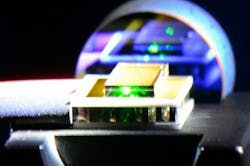External-cavity diamond Raman laser increases pump brightness by 50%
A team from the Macquarie Photonics Research Centre at Macquarie University (Sydney, Australia) has created an external-cavity diamond Raman laser, pumped by a pulsed (36 kHz) 1064-nm-emitting NdYAG laser and emitting light at the eye-safe 1485 nm wavelength, that increases the brightness of the incoming beam by 50%. While the beam quality is improved by a factor of 2.7, the conversion efficiency is 40% (resulting in an average output power of 16.2 W), which leads to the 50% brightness increase.1
The diamond crystal is several millimeters long. The major advantage of using diamond is its outstanding ability to dissipate heat (better than any other material), allowing conversion to be achieved passively in a very small package.
The beam conversion occurs via stimulated Raman scattering, which has been studied in diamond at Macquarie University extensively for the past five years, as reviewed by co-researcher Richard Mildren and colleagues in the new book Optical Engineering of Diamond.2 "The Raman process not only improves the beam quality but also converts the color of the laser beam," says Mildren.
With the proof of concept, and now patent protection, the researchers next plan to demonstrate conversion of higher powers and with lasers at other wavelengths. The work was supported by the Asian Office of Aeronautical Research and Development.
REFERENCES
1. Aaron McKay, Ondrej Kitzler, and Richard P. Mildren, Laser & Photonics Reviews (2014); doi: 10.1002/lpor.201400012
2. Optical Engineering of Diamond, Rich Mildren (Editor), James Rabeau (Editor); ISBN: 978-3-527-41102-3; May, 2013.

John Wallace | Senior Technical Editor (1998-2022)
John Wallace was with Laser Focus World for nearly 25 years, retiring in late June 2022. He obtained a bachelor's degree in mechanical engineering and physics at Rutgers University and a master's in optical engineering at the University of Rochester. Before becoming an editor, John worked as an engineer at RCA, Exxon, Eastman Kodak, and GCA Corporation.
